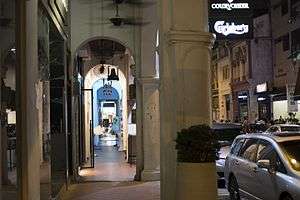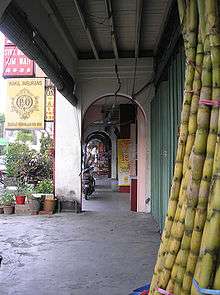Five foot way
Five foot ways (Malay/Indonesian: Kaki lima) are 5 feet (1,524 metres) wide pedestrian walkways pavement indented from the ground floor of a building into the road. This feature can be found in many shophouses (and buildings of similar structural design) all over the world, and also in some office buildings.[1][2]

The examples of five foot pedestrian walkways can be found dated from colonial Indonesia, Malaysia and Singapore. Such as those walkways along Old Batavia in Jakarta, Braga Street in Bandung, Georgetown in Penang and Shenton Way in Singapore. In Indonesia, the term kaki lima has become synonymous with street food, since in the country numbers of warung humble tent shops or gerobak food carts often occupying this five-foot wide pedestrian sidewalks.[3]
Description

The term five-foot describes the width of the sidewalks projected from the wall of the building into the street. The overhanging canopy, roof extension, or projected upper floor on top of the five foot pathways can provide a cover to shield pedestrians from the sun and rain. As the ground floor of most commercial buildings in downtown areas are shops or eating places, the five foot ways can also function as a corridor for people to window-shop or stop by for some refreshments.
As implied by name, five foot ways were intended to assume a consistent width of five feet from the absolute front to the wall and entrance defining the frontal of the inner space, but the guideline is not necessarily applied universally, as certain five foot ways are wider or narrower depending on the age, size and function of the building.[1]
History
In the early 19th century colonial Dutch East Indies during British Java period, The Governor General Sir Thomas Stamford Raffles ordered the construction of sidewalks along the main streets of Batavia of a certain height and width: 1 foot (33.5 centimeters) high by about 5 feet wide.[4]
In Singapore, five foot ways date back to the time of the Colonial Government, when Stamford Raffles included this[5] and other details in his Town Plan of 1822; the feature was eventually integral in many settlements in neighbouring British colonies, and remains a prominent element in modern architecture in Singapore, Malaysia and Brunei. Attempts in Singapore to clear the walkways of hawkers in the 1880s led to the so-called "Verandah Riots".[6]
This feature spread to other South East Asian cities from around the mid-nineteenth century, and also began to appear in other cities and market towns in South China in the early twentieth century in the form of qilou.[7]
Terminology
In Indonesian term, kaki lima is interchangeable with trotoar (from French via Dutch: trottoir), as both refer to pedestrian pathways or sidewalks. In Indonesian colloquial term pedagang kaki lima refer to street hawker that often occupy the pedestrian or walkways along the busy street. The kaki lima in Indonesia offered a potpourri of goods such as socks, blouses, pots and pans. In fact, nowadays sidewalks are often occupied by small eateries and stands.[4]
The Malay term for "five foot way", kaki lima (literally translated as only "five foot"), is also used generally to refer to corridors or verandas, regardless of their width. Actually the Malay translation was not correct: as 5 feet should be lima kaki, instead of kaki lima.[4]
See also
- Verandah
- Portico
External links
References
- 1 2 Christopher Torchia; Lely Djuhari (2015). Indonesian Idioms and Expressions: Colloquial Indonesian at Work. Tuttle Publishing. pp. 235–236. ISBN 9781462916504.
- ↑ "kaki lima". sederet.com Online Indonesian - English Dictionary.
- ↑ "Most popular 'kaki lima' in Jakarta". The Jakarta Post. Jakarta. 18 June 2016.
- 1 2 3 Suryatini N. Ganie (19 December 2010). "The 5 feet story of Thomas Stamford Raffles". The Jakarta Post. Jakarta.
- ↑ Singapore: A Pictorial History 1819-2000, By Gretchen Liu
- ↑ The History of Singapore, By Jean Abshire
- ↑ Jun Zhang (2015). "Rise and Fall of the Qilou: Metamorphosis of Forms and Meanings in the Built Environment of Guangzhou" (PDF). Traditional Dwellings and Settlements Review. 26 (2): 26–40.